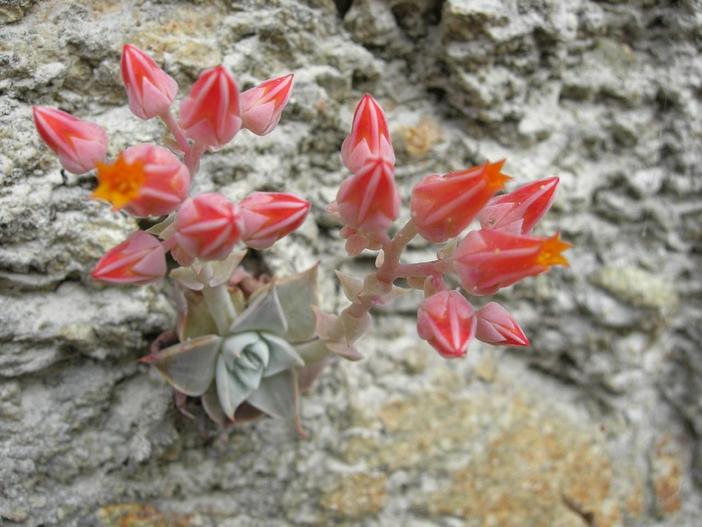Low Canyon Dudleya
(Dudleya cymosa subsp. pumila)
Low Canyon Dudleya (Dudleya cymosa subsp. pumila)
/
/

Joe Decruyenaere
CC BY-SA 2.0
Image By:
Joe Decruyenaere
Recorded By:
Copyright:
CC BY-SA 2.0
Copyright Notice:
Photo by: Joe Decruyenaere | License Type: CC BY-SA 2.0 | License URL: https://creativecommons.org/licenses/by-sa/2.0/ | Uploader: joedecruyenaere | Publisher: Flickr






















Estimated Native Range
Summary
Dudleya cymosa subsp. pumila, commonly known as low canyon dudleya or California live-forever, is a perennial succulent native to the rocky cliffs and steep, south-facing slopes in chaparral and coastal sage scrub of the Transverse and Peninsular Ranges in California. It typically grows 2-6 inches tall and forms rosettes with diamond to spoon-shaped leaves that are often coated with a white powdery substance, which helps reflect sunlight and conserve water. From May to July, it produces bright red, orange, or yellow flowers on short inflorescences, which are particularly showy and attract pollinators. The plant is diploid and can be found at elevations ranging from 300 to 8,500 feet, where it serves as a larval food plant for the Sonoran blue butterfly.
In cultivation, low canyon dudleya is valued for its drought tolerance and striking appearance, making it a popular choice for rock gardens, succulent collections, and xeriscaping. It requires minimal maintenance, thriving in well-draining soils and needing only occasional water once established. It prefers full sun to light shade and is best propagated by offsets or seeds. While generally disease-resistant, it can suffer from root rot if overwatered. Gardeners should be aware that Dudleya species are often targeted by poachers and should be sourced from reputable nurseries.CC BY-SA 4.0
In cultivation, low canyon dudleya is valued for its drought tolerance and striking appearance, making it a popular choice for rock gardens, succulent collections, and xeriscaping. It requires minimal maintenance, thriving in well-draining soils and needing only occasional water once established. It prefers full sun to light shade and is best propagated by offsets or seeds. While generally disease-resistant, it can suffer from root rot if overwatered. Gardeners should be aware that Dudleya species are often targeted by poachers and should be sourced from reputable nurseries.CC BY-SA 4.0
Plant Description
- Plant Type: Succulent
- Height: 0.5-1 feet
- Width: 0.5-1 feet
- Growth Rate: Moderate
- Flower Color: Yellow
- Flowering Season: Spring
- Leaf Retention: Evergreen
Growth Requirements
- Sun: Full Sun
- Water: Low
- Drainage: Fast
Common Uses
Butterfly Garden, Drought Tolerant, Fire Resistant, Low Maintenance, Rock Garden, Showy Flowers
Natural Habitat
Rocky cliffs and steep, south-facing slopes in chaparral and coastal sage scrub of the Transverse and Peninsular Ranges in California
Other Names
Common Names: Dwarf Canyon Liveforever, Dwarf Liveforever
Scientific Names: , Dudleya cymosa subsp. pumila, Cotyledon bernardiana, Cotyledon pumila, Cotyledon roseana, Dudleya bernardiana, Dudleya goldmanii, Dudleya pumila, Echeveria bernardiana, Echeveria goldmanii
GBIF Accepted Name: